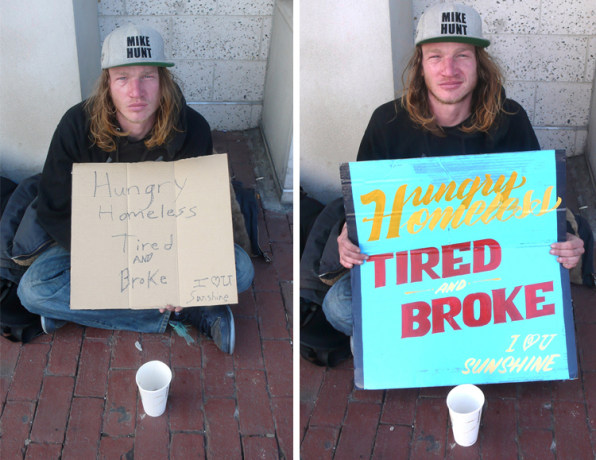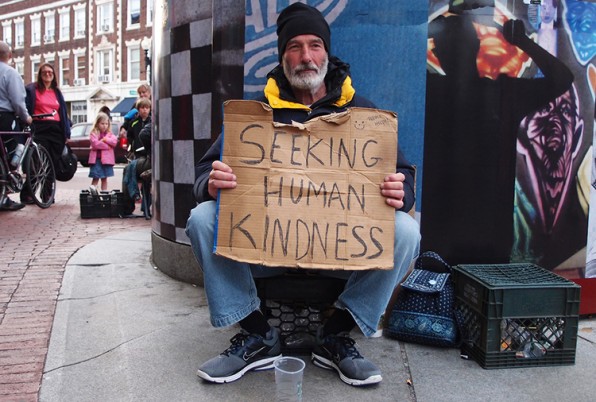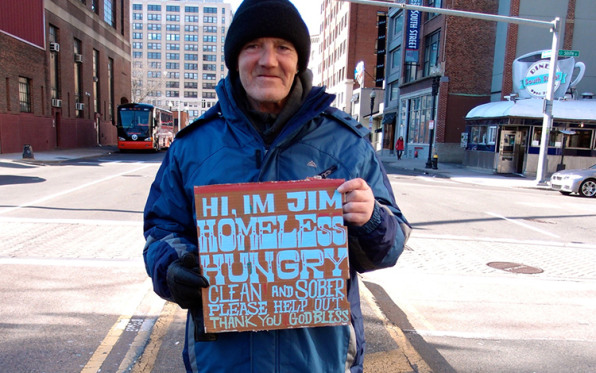Can a Complete Blind Man Be a Graphic Designer
The least visible franchises can be given a new voice through the power of good branding and great graphic design. Will it do the same for the voiceless, the invisible, the institutionally disenfranchised? Can well-executed design change the lives of the homeless?
A new project in Boston and Cambridge, Massachusetts, is trying to find out. A collaboration between artist Kenji Nakayama and Christopher Hope, the Signs for the Homeless project exchanges handwritten panhandling signs for colorfully illustrated, eye-catching recreations that aim to give the homeless a power that most of us take for granted: The power to be noticed.
"Homelessness is the white noise of the community," Hope tells Co.Design. "We live in a world that is so saturated by design and branding that these homemade begging signs just get drowned out." But the tattered signs that the people on our streets wave a thousand times a day to catch our attention aren't just for begging. As Hope is quick to point out, many homeless signs don't ask for money or food at all. Instead, they are works of self-expression: Statements by a human being about the world they live in.

"I see signs all the time where the homeless make a political or religious statement," says Hope. "Many are not using their signs to make money at all. They're using them as a voice, to reach out."
It's a voice that largely goes unheard. Culturally, most of us don't want to think of the message scrawled in Sharpie on a mottled piece of cardboard as the voice of another person. In fact, homelessness seems like such an intractable social problem that even compassionate people simply put their blinders on when they walk down the street. To even glance at a homeless person's sign could be taken as a sign of engagement, and the prospect of engaging with a person you don't know how to help is heartbreaking. So we treat them like ghosts.
What Kenji and Hope want to do with their Signs for the Homeless is rip those blinders off, with graphic design too good to be denied. "We want people to see these signs, and be curious about the person holding it," says Hope. "We want them to go up and say, 'Nice sign, where'd you get it?'"

An advocate for the welfare of the homeless who spends his days helping people who live on the streets, Hope says anyone can approach him for a new sign. When someone approaches Hope, they'll then work with Kenji to come up with a design that suits them. "They tell us what they want," says Hope. "What they want the sign to say, what colors they like, even maybe what kind of lettering they want." Once a sign is complete, Hope then interviews the recipient, photographs them, and gives them a small donation of around $20.
The interviews are an integral part of the project, and the social aspect that was missing from the picture despite Kenji's first solo efforts. Hope's contribution to the project is a stark glimpse into the realities of homelessness, and the many reasons people are driven to the streets.
"Literally anyone can become homeless," explains Hope. As a demographic, the homeless are not just a group made up of the stereotypical street people we expect–the abused, the mentally ill, the druggies, and the drunks–but people who are homeless because of accident or design. Being made homeless by job loss, medical bills or both is a common story, but there are also people who just choose to be homeless, such as Jimmy Sunshine, who panhandles in Somerville, Massachusetts. Jimmy became homeless after realizing that he was working himself to death at a low paying job only to spend his off hours starving to afford a cheap apartment. Instead of starving to pay rent, Jimmy reasoned, why not ditch the apartment and "eat like a king outside?"

Do the new signs actually make a difference in the lives of the homeless? On an individual level, as with many aspects of the homeless problem, the answer isn't clear-cut. Hope says that the new signs can lead to more panhandling money, but it can also make the owner a target. "The truth is being homeless is one of the most vulnerable positions anyone can be in," says Hope. "These people live lives that are constantly in flux. Some people lose their signs, or have to leave them behind. Others might have their signs stolen off them."
And some homeless might be just too used to being ignored and marginalized to deal with the attention brought by carrying around one of Kenji's vivid signs. While I interviewed Hope at a local coffee shop in Cambridge's Central Square, a local homeless woman named Angela happened by. Asked about the sign Hope and Kenji made for her, Angela was evasive about what had happened to it. Eventually, Angela shyly admitted that although she had been given a sign, she had never even used it.
So if the homeless lose their signs, or never use them, or get robbed for them, then what's the point? Alone, putting more attractively designed signs in the hands of panhandlers is just a placebo to the homeless problem. As Hope sees it, the panacea to the social disease of homelessness is conversation: Not just the larger conversation about how to help the homeless reintegrate with society, but the individual conversations that might be sparked when a well-designed panhandling sign catches someone's eye and he decides to go up and talk to the person holding it.
"Good design helps you see the world in a different way," says Hope. Design is a powerful force that can help overpower people's preconceptions and attract us to the very things we were once repelled by. Good design can't in itself help the lives of the homeless, but it can help give the homeless back their voice and humanity. If it can do that, design doesn't need to solve the homeless problem. We can do it ourselves.
Kenji Nakayama and Christopher Hope are interested in expanding the Signs for the Homeless program to other states, and working to form a nonprofit. If you are interested in helping, please reach out to christopherchope@gmail.com.
Can a Complete Blind Man Be a Graphic Designer
Source: https://www.fastcompany.com/1673225/can-good-graphic-design-help-the-homeless
0 Response to "Can a Complete Blind Man Be a Graphic Designer"
Post a Comment